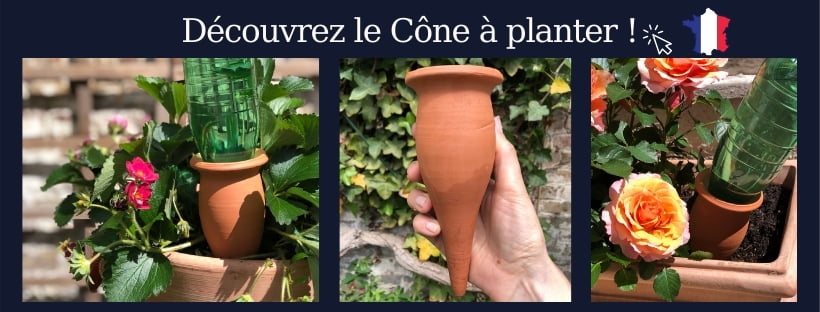
Water your plants with mineral water
of reading
As a concerned gardener, you may be wondering if mineral water would improve the health of your plants? Is it good or is it a false good idea? Is there a cheaper source than bottled water?
We test lots of tips for your plants every day and know exactly how to help you.
Mineral water is very rich in nutrients for plants. The minerals and micronutrients it contains accelerate plant growth and development. However, highly mineralized water can hinder plant development. Some plants prefer demineralized water.
This article will teach you:
- The advantages and disadvantages of mineralized water,
- Can you water with sparkling water?
- A free source of water containing minerals.
What's in your water and its effects on your plants will now be a mystery to you. You'll know which water to use the next time you reach for your watering can.
Is mineral water the best water for your plants?
Before explaining how to do this, it is important to remember the positive and negative effects of minerals on plants .
1. The benefits of minerals for plants
Mineral water contains salts and minerals not typically found in tap water. These micronutrients may occur naturally at the site where the water is collected or may be added during bottling.
Sodium , calcium , potassium or sulfates are among the salts and minerals essential for plant growth .
Bottled spring water is therefore a very pure type of water. Bottlers collect it from underground sites where the water naturally flows to the surface. As it flows through the rocks, it absorbs natural minerals. It is also free of any contaminants and agricultural chemicals.

The downside would be its price and rarity. If you're not lucky enough to live near a spring, you'll have to find other solutions. It would n't be very environmentally friendly to ship your water bottles from the other side of France just for your plants.
The difference for plants between mineral water and demineralized water:
Watering with demineralized water would allow our plants to survive, but would not give them the strength to continue growing and developing their foliage. This type of water should be reserved for plants that absorb their minerals and nutrients otherwise .
Carnivorous plants , for example, are used to growing in very poor soils. They therefore draw their resources from insects that they capture and digest. Giving mineral water to a carnivorous plant could kill it . Its root system has adapted to its natural environment to the point of becoming very sensitive.
2. Water that is too highly mineralized is bad for your plants
For our health, it is sometimes recommended to consume highly mineralized water . These waters contain high concentrations of salts and minerals , which we do not find in tap water .
However, these same minerals that are essential to our health are bad for our plants in large quantities . Store-bought bottles labeled "mineral water" can contain 1,000 to 3,000 parts per million of these minerals .
Watering plants with such mineral-rich water will quickly create a buildup of minerals in the soil. When plants absorb water, most of the minerals remain in the soil . They are too large to pass through the membranes of the root system .
In summer, when water evaporates, minerals also remain in the soil. Over time, the accumulation of minerals can change the composition of the soil and become toxic. Sodium, calcium, and magnesium salts may leave white or brownish residue on the inside edges of plant pots, on the soil surface, or around plant stems.
If you notice this, you can reduce the buildup by rinsing the pot with distilled water, rainwater, or melted snow. This will help leach out some of the harmful minerals that have accumulated.

Beware of excess calcium:
Calcium is one of the minerals commonly found in mineral water. Plants need it, but like any other nutrient, too much of it becomes toxic . Excess calcium can lead to alkaline conditions, or high pH levels, in the soil. This can lead to a "lockout" of iron, potassium, magnesium, and manganese.
Beware of excess sodium:
Sodium is another common mineral found in bottled water. Too much salt in the soil prevents water from reaching plant roots . This is due to the workings of osmosis , which moves water from areas where salt water is more diluted to areas where it is more concentrated.
3. Can we water with sparkling water?
Sparkling water contains nutrients that are easily absorbed by the plant's root system . Nutrients in sparkling water may include magnesium, calcium, sodium, sulfur, phosphorus, and potassium. This water also contains carbon dioxide . CO2 increases nitrogen levels , the amount of plant nutrients, and the rate of photosynthesis in leaves.
Sparkling water is therefore water rich in minerals which should give your plant a little boost.
But as we saw above, you should only use this water very occasionally . Sodium is a mineral that should not accumulate in your flower pot.
The main drawback for us would be its daily cost. We think this is a one-time trick, to be used when your sparkling water has lost its bubbles.

4. Where can I find mineral water for my plants?
Finally, we'll discuss which bottled water brand to choose for the best results. We'll also introduce you to another eco-friendly method for getting pure water for free.
Our goal is to help you find a solution without using spring water from the other side of the world.
A) Bottled water
Given the pros and cons, we recommend using mineral water only very occasionally. Its cost and scarcity make it a precious water that would be a shame to waste.
For our part, we use this water, with bottles that we wanted to throw away anyway.
As we have told you, the more mineralized your water is, the less often you will need to give it to your plant.
Evian is a mineral water that we do not recommend watering daily . Its high mineral content may be beneficial in small doses, but can be harmful in the long run.
Cristalline, on the other hand, is a much less mineralized spring water with which you can water your plants without taking too much risk.
Once your bottle is empty, you can also recycle it into a homemade watering can. Check out our article on How to Make a Watering Can from a Water Bottle .
B) Rainwater
If you were to water your plants with only one type of water, we would recommend rainwater. This natural water is of unparalleled purity and contains everything you need. For garden plants, nothing could be simpler; Mother Nature takes care of everything for us.
However, how do we irrigate our indoor plants with it?
Don't worry, this is quite easy to do! All you need to do is place a basin or bucket of water at the outlet of your gutter .
As you can see, this technique is much more environmentally friendly and economical than watering with a water bottle. For us, it's the best possible compromise between benefits and simplicity.
Grab your watering can and take action!
As we have seen, the type of water you use has a big influence on the growth of your plants.
Now you know everything about watering with mineral water, and you also know another source of water that is more ecological and economical.
But no matter what water you use, it's also how you water that will influence how quickly your plant grows. The watering can is a timeless gardening tool that allows for controlled and successful watering. Their long, thin spout allows you to control the amount of water released and concentrate it toward the plant's root system.
Discover them now by clicking on the image below.









Degouey
Peut onarroser les orchidées avec de l’eau additionnee de moringa en feuilles . Merci